Dive into the fascinating history of ancient Egyptian clothing, from the luxurious linen of royalty to the practical garments worn by commoners. Explore their advanced textile techniques, the cultural and symbolic significance of attire, and the evolution of fashion shaped by foreign influences.

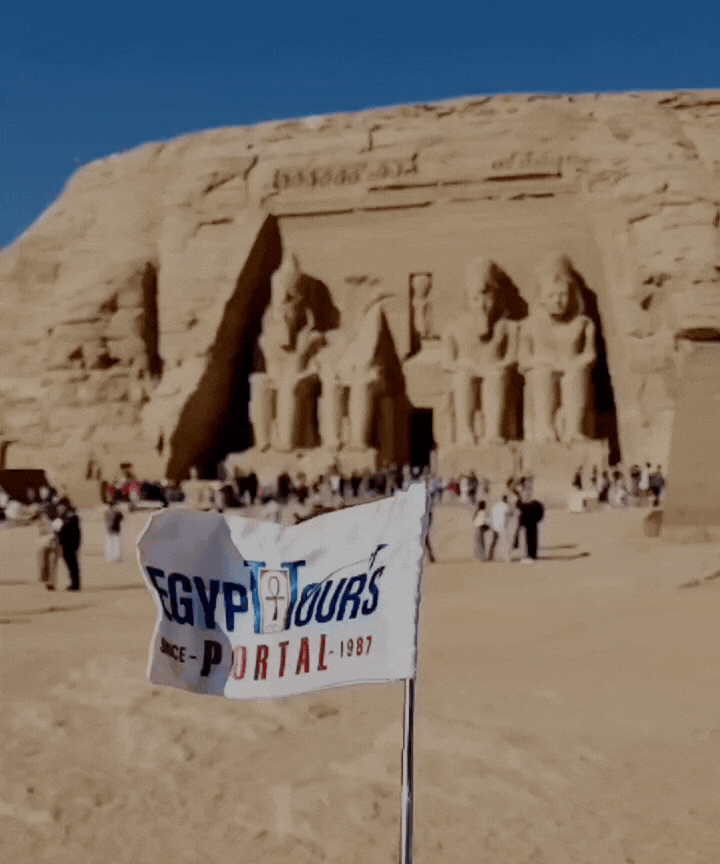
Ancient Egyptian clothing is a living symbol of the ingenuity and resourcefulness of one of the world's oldest civilizations which also offers a window into their daily lives, beliefs, and social structures. From the fine, translucent linen worn by pharaohs to the practical kilts and dresses of commoners, Egyptian attire was shaped by the region's hot climate, abundant resources, and deep cultural values. Every garment, accessory, and adornment symbolized the wearer’s status, role, and connection to the divine.
Over millennia, the evolution of Egyptian clothing showcased their advanced textile techniques, artistic expression, and adaptability to foreign influences. Whether through the intricate pleating of royal robes, the use of gold and gemstones in jewelry, or the practicality of simple sandals, their clothing was a harmonious blend of function and symbolism. This article explores the materials, styles, and cultural significance of ancient Egyptian clothing, shedding light on how this remarkable civilization wove its identity into every fiber of its attire.
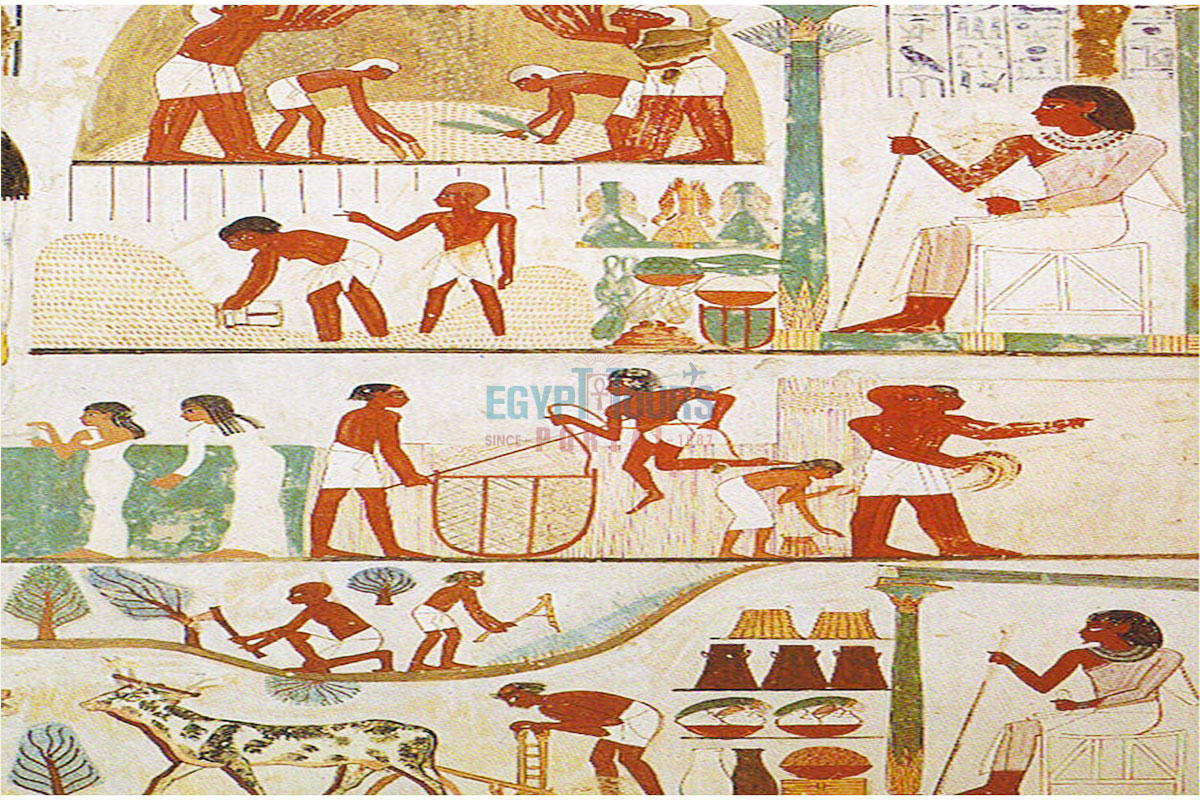
Ancient Egyptian fashion evolved over millennia, blending simplicity, functionality, and symbolic adornment to reflect societal norms, environmental needs, and cultural values. Beginning in the Early Dynastic Period (c. 3150 BCE), clothing transitioned from animal hides to linen, prized for its breathability in Egypt’s arid climate. The Old Kingdom (c. 2613–2181 BCE) saw distinctions between classes, with upper-class women donning long dresses and men wearing kilts, while practicality defined lower-class attire.
The Middle Kingdom (c. 2040–1782 BCE) introduced pleated gowns, longer kilts, and elaborate wigs, signaling increased sophistication. In the New Kingdom (c. 1570–1069 BCE), fashion became more vibrant, with intricate embroidery, jewelry, and refined wigs, exemplified by King Tutankhamun's garments. The Late Period and Ptolemaic Dynasty (c. 664–30 BCE) brought Greek and Persian influences, blending external styles with Egyptian traditions. Throughout its history, white linen symbolized purity, gold reflected divinity, and kohl offered both practical and spiritual protection.
Despite external influences and trade introducing new materials, Egyptian fashion retained its essence, harmonizing elegance with functionality and leaving a timeless legacy of artistry and cultural identity.
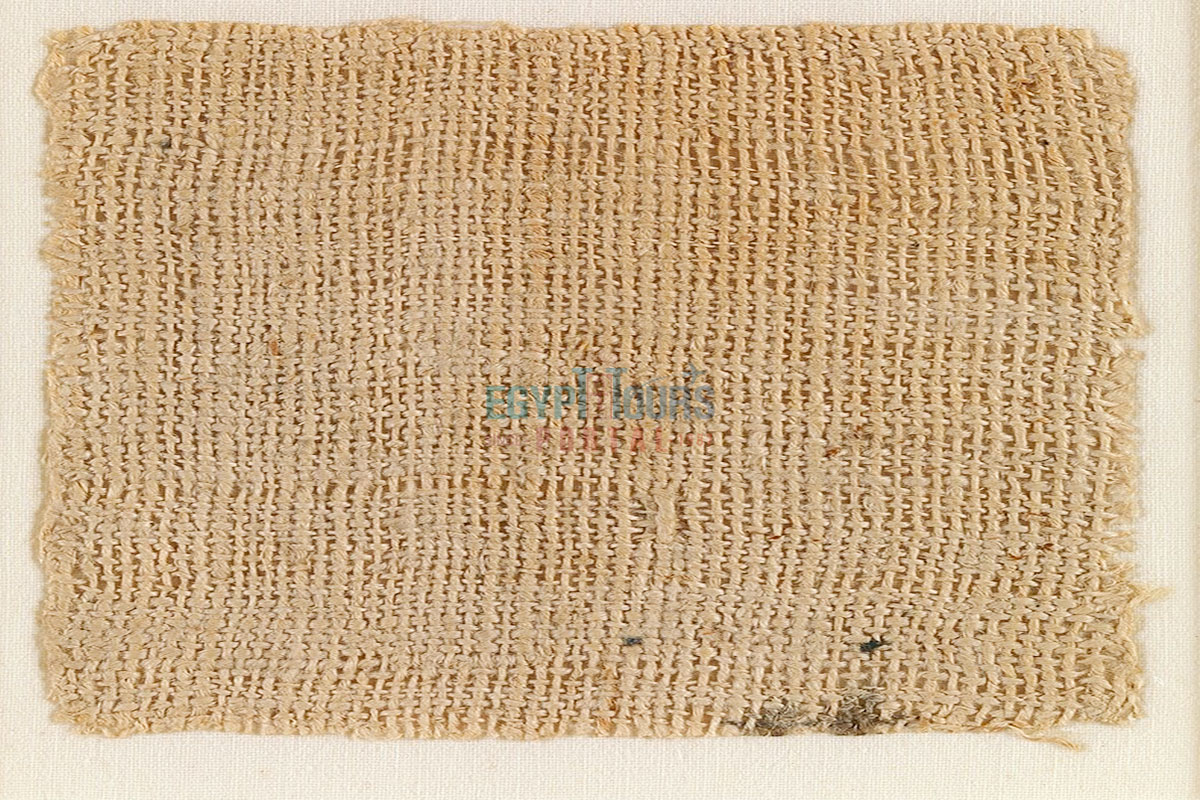
Linen, derived from the flax plant, was the cornerstone of ancient Egyptian clothing due to its lightness, durability, and suitability for the region's arid climate. Its production was deeply integrated into the agricultural and economic systems of the Nile River Valley, dating back to circa 5000 BCE. By the Old Kingdom (2686–2181 BCE), linen had become a staple material in everyday clothing, religious practices, and even burial rituals.
Flax plants were cultivated in the fertile Nile Delta, taking advantage of the annual inundation that enriched the soil. The plants were harvested before flowering to yield the finest fibers. Workers pulled the plants from the roots rather than cutting them to maximize fiber length, essential for creating durable and high-quality linen.
Retting: Stalks were soaked in water for several days to loosen the fibers from the woody stem. This process was carefully timed to avoid weakening the fibers.
Beating and Combing: After retting, the softened stalks were beaten to separate the fibers, which were then combed to produce fine strands.
Spinning: The combed fibers were spun into thread using hand spindles and whorls. This labor-intensive process determined the thread’s thickness and quality, with finer threads reserved for luxury textiles.
Weaving: Threads were woven on horizontal looms, introduced as early as the Predynastic Period (c. 6000–3150 BCE). Skilled weavers, often women, crafted fabrics ranging from coarse, functional cloth to gossamer-thin, translucent linen favored by the elite.
Linen was categorized by its weave, thread count, and thickness. Archaeological finds show textiles ranging from coarse cloth used for everyday wear to fine linen called “royal linen,” used in temple offerings and royal garments. Linen garments were also used as currency and tribute, underscoring their value in both domestic and international trade.
Linen’s pale color symbolized purity and was often left undyed, especially for religious purposes. Priests and those involved in temple rituals wore pure white linen garments, as wool and other animal-derived fabrics were considered ritually impure.
Fine linen was a luxury item, signifying wealth and status. Royal tombs, such as that of Tutankhamun, contained dozens of linen garments, highlighting its importance in both life and the afterlife.

Despite the difficulty of dyeing linen due to its smooth fibers, the Egyptians developed innovative methods to add color to their textiles. These dyed fabrics were rare and highly valued, often reserved for ceremonial purposes or the elite.
Dyes were mixed with mordants such as alum to fix the colors. Fabric pieces were dipped in boiling dye baths and left to dry in the sun, repeating the process to achieve deeper hues.
Dyed linen is often featured in ceremonial garments, banners, and temple hangings. Certain colors were imbued with protective or spiritual significance, such as blue, which symbolized the protective power of the goddess Hathor.
Fragments of dyed textiles have been found at sites like Deir el-Medina, demonstrating advanced textile technology. Painted depictions in tombs also suggest that fabrics may have been adorned with intricate patterns and embroidered borders, combining color and texture for aesthetic appeal.

Clothing served as a visual declaration of status and divinity for the pharaohs and nobility. Their garments were crafted from the finest linen and embellished with intricate details.
The shendyt: A pleated kilt worn by pharaohs, was made from fine, almost transparent linen. Pleating added both texture and an element of luxury.
Animal Skins: Leopard skins, often draped over the shoulders, were symbols of divine authority and used in religious ceremonies to emphasize the ruler’s connection with the gods.
Headdresses: Pharaohs wore the nemes, a striped cloth headdress symbolizing their role as the unifier of Upper and Lower Egypt. The uraeus (cobra symbol) on the nemes denoted protection by the goddess Wadjet.
Garments for the nobility featured gold-thread embroidery, elaborate beadwork, and precious stones such as lapis lazuli and turquoise.
Wealthy women often wore flowing, sheer dresses layered with colorful shawls or capes for added elegance.
Festival attire included intricate jewelry, such as the usekh collar, and embellished clothing. These outfits were depicted in tomb paintings, emphasizing their ceremonial importance.

The majority of Egyptians wore simple, functional clothing suited to their daily lives.
Men’s clothing evolved subtly over the centuries, maintaining a balance between practicality and social distinction:
Old Kingdom: The shendyt, Short kilts were the standard garment for male workers and farmers, preferred for their ease of movement. Linen garments were often undyed, reflecting practicality and cost-efficiency.
Middle Kingdom: Longer kilts with pleats and sashes signified increased wealth.
New Kingdom: Sheer blouses and intricately pleated kilts became popular among the upper classes, reflecting greater prosperity and external influences.
The kalasiris, a sleeveless sheath dress, was made from coarser linen and secured with straps. Shawls and Capes were for wealthier women who used these as outer layers for warmth or modesty. Variations in length or adornment distinguished working-class women from the elite. Elite women wore brightly decorated linen dresses, while working-class women relied on simple, coarse fabrics.
Children often went unclothed until around age six, a practical response to the heat and active nature of childhood. Wealthier children sometimes wore simple linen garments or adorned themselves with jewelry.
Tomb paintings depict laborers wearing minimal clothing or working nude in harsh environments like construction sites and quarries. This practice allowed for greater mobility and minimized wear on garments.
Explore more fascinating details about the daily routines, beliefs, and traditions of the Egyptians.
Read More
Jewelry was not merely ornamental but deeply symbolic, serving spiritual and protective functions:

Wigs were essential for hygiene, fashion, and ceremony:
Materials and Crafting: Human hair and plant fibers were woven into elaborate styles.
Symbolism: Wigs denoted status and were often paired with perfumed cones for festive occasions.
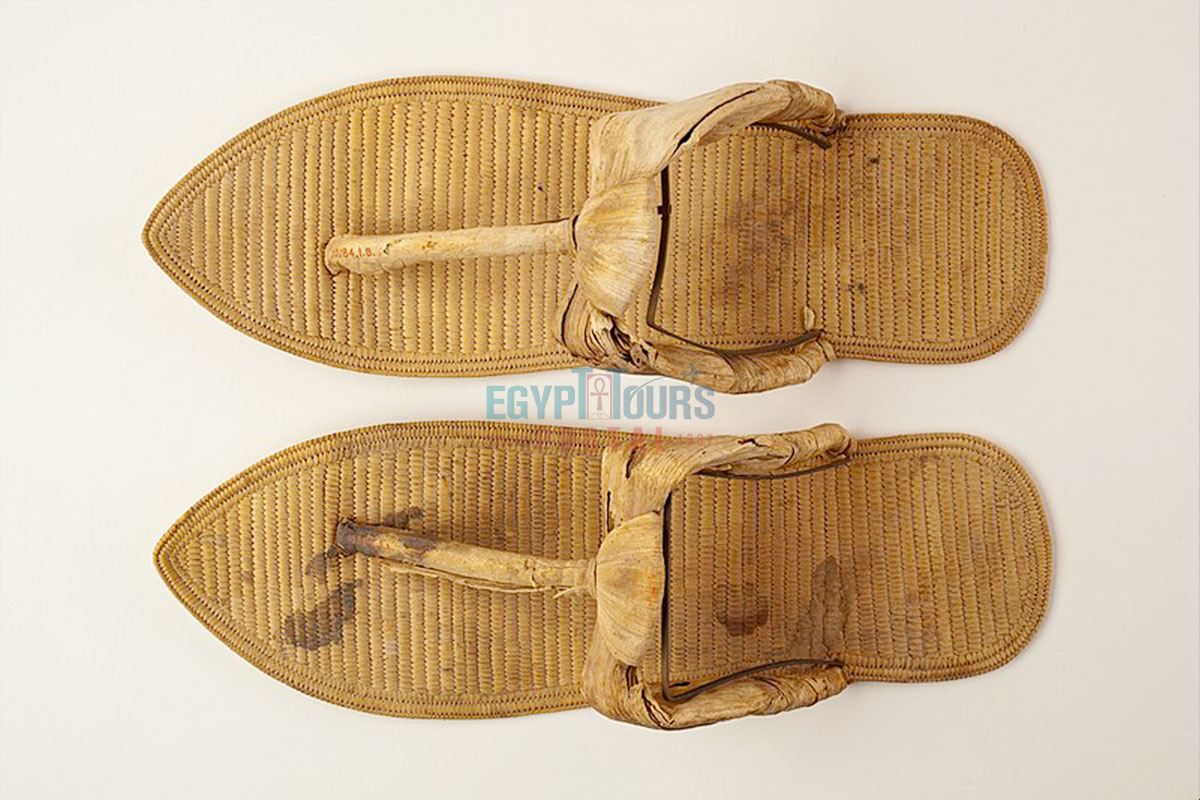
Footwear in ancient Egypt was as much a marker of social status as it was a functional necessity. Sandals were the most common form of footwear and were skillfully crafted from readily available materials. The materials and designs varied according to the wearer’s class and purpose:
Sandals typically consisted of a flat sole with straps or thongs securing them to the foot. Archaeological finds reveal various strap styles, including those crossing the foot or looping between the toes.
Sandals discovered in Tutankhamun’s tomb, dating to the 14th century BCE, demonstrate exceptional craftsmanship. Among the 90 pairs found, some were ceremonial, featuring gold decorations and designs depicting conquered enemies on the soles—symbolizing the pharaoh’s dominance over his foes.
Cobblers, depicted in tomb reliefs and workshop scenes, used tools such as awls, knives, and needles to assemble sandals. Tomb paintings from the Old and New Kingdoms show cobblers at work, emphasizing their importance in society.
For much of the population, going barefoot was both a practical and cultural norm. Sandals, while common, were not essential for daily life and were often reserved for specific situations:
The soft sands and warm climate of Egypt made barefoot walking comfortable for most of the year.
Sandals were worn primarily in rocky or hazardous terrain, during travel, or for ceremonial purposes.
Bare feet symbolized humility and purity in certain religious contexts, such as when entering temples.
Workers and laborers, particularly those involved in construction, farming, or quarrying, often went barefoot to maintain agility and ease.
While the elite and priests used sandals adorned with luxurious materials, even they often chose to walk barefoot within their homes or on softer grounds.
Barefoot practices highlight the practicality of ancient Egyptian culture, where function often took precedence over decoration for the lower classes.

Cosmetics were integral to Egyptian daily life, blending practicality with cultural significance. Both men and women adorned themselves with makeup, emphasizing the belief in personal presentation and its connection to spiritual well-being.
A black eyeliner made from powdered galena (lead sulfide) or stibnite, kohl was applied around the eyes using sticks or reeds.
Beyond its aesthetic appeal, kohl protected against the harsh sun’s glare, reduced the risk of infections and symbolized protection from the gods, particularly Horus.
Derived from the Lawsonia inermis plant, henna was used to dye nails, hair, and even skin. Its reddish hue symbolized vitality and rejuvenation.
Red ochre, mixed with fat or water, was applied as a rouge to cheeks and lips. Yellow ochre was occasionally used for lighter tones, signifying youth and beauty.
Cosmetic jars, palettes, and applicators were crafted from alabaster, faience, or ivory, often intricately carved. Some jars doubled as luxury items, adorned with depictions of gods or animals.
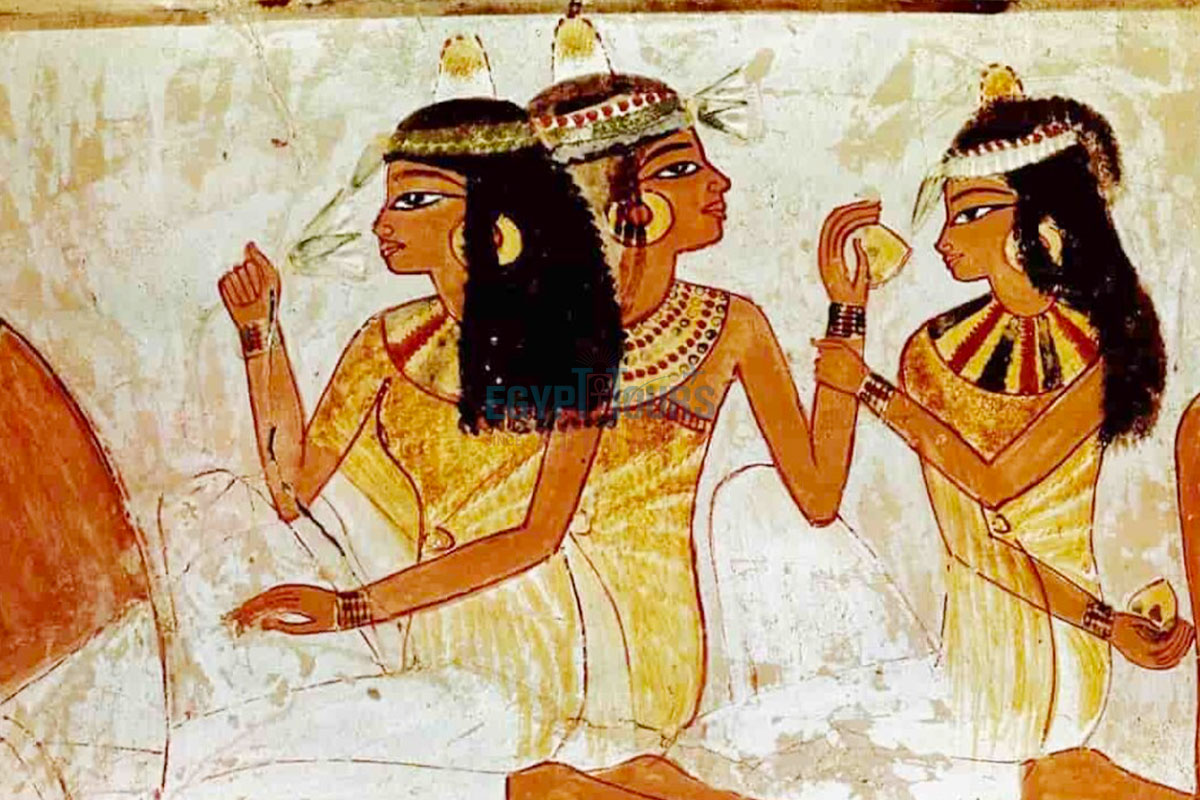
Perfumes and oils played a vital role in both daily life and rituals, reflecting the Egyptians’ emphasis on cleanliness and sensory enhancement.
A fragrant blend of myrrh, frankincense, honey, and spices, kyphi was used as a perfume, incense, and even medicine. Records from the New Kingdom list detailed recipes for its preparation.
Scented oils, infused with herbs or flowers like lotus and jasmine, were used to moisturize the skin and protect it from the arid climate. Wealthier Egyptians imported exotic oils from regions such as Punt (modern-day Somalia or Ethiopia).
Perfumed cones, often worn atop wigs, melted to release fragrance during banquets and festivals. The scented oils also had a purifying role in religious ceremonies.
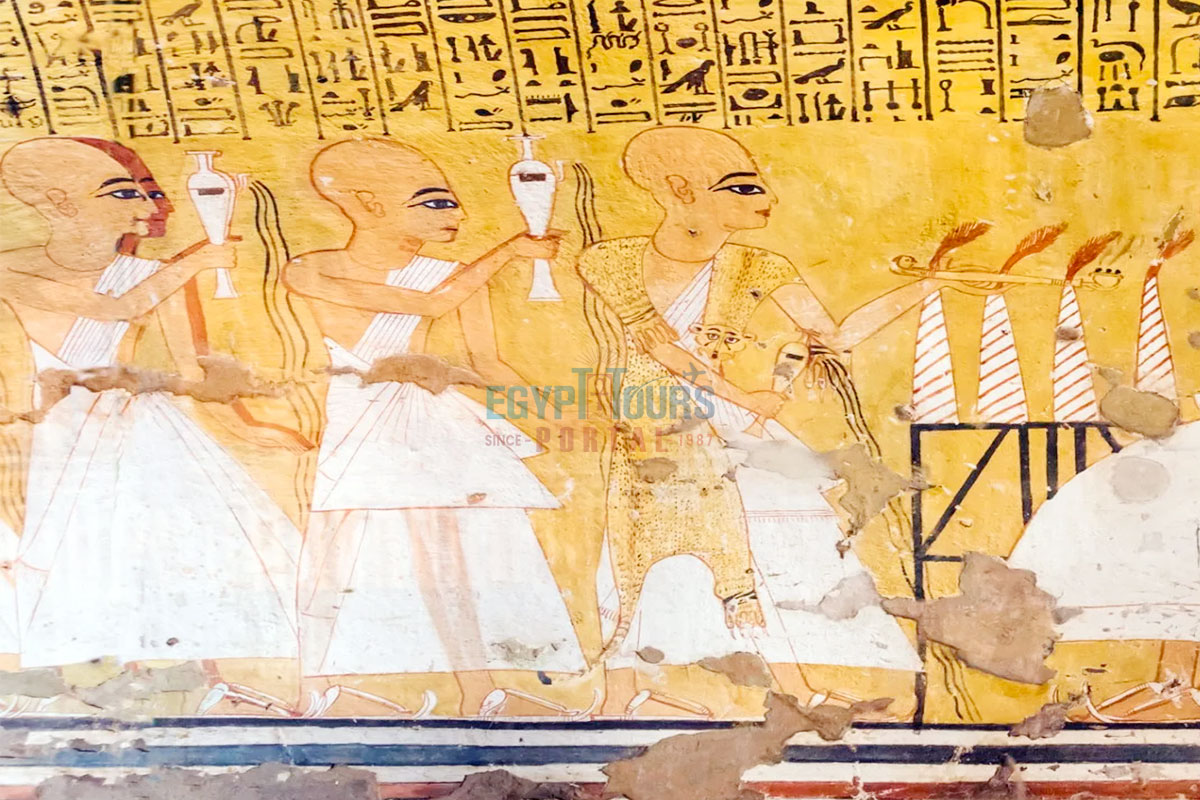
Priests adhered to strict dress codes dictated by religious requirements:
Symbolizing purity and light, priests wore white garments free from impurities. Wool and other animal-derived materials were forbidden in sacred spaces.
The robes were often paired with simple sashes or belts.
Priests shaved their entire bodies, including eyebrows and hair, to maintain ritual cleanliness. This practice underscored the importance of hygiene in religious service.
High-ranking priests or those performing significant ceremonies wore leopard pelts, representing the spiritual connection between humans and deities.
The attire of the deceased was carefully chosen to reflect their status and ensure their protection and comfort in the afterlife.
Mummies were wrapped in multiple layers of linen, often with intricate bandaging patterns. Royal burials sometimes included over 20 layers of linen, with each layer inscribed with protective spells.
Amulets, such as heart scarabs and ankhs, were placed within the wrappings. These objects were believed to protect the deceased and grant them passage to the afterlife.
Jewelry included gold bracelets, rings, and necklaces, signifying the wealth and status of the individual.
Elaborate masks, such as the famed gold mask of Tutankhamun, were crafted to preserve the deceased’s likeness and honor their divine connection.
Explore glorious details about the beliefs and attire of the religion of the ancient Egyptians.
Read More
Egypt’s interaction with neighboring civilizations introduced new elements:
The conquest of Nubia brought vibrant textiles, bold patterns, and additional uses of gold and semi-precious stones.
During the Ptolemaic period (305–30 BCE), Greek-style tunics, cloaks, and silk fabrics blended with traditional Egyptian fashion, creating a cosmopolitan style.
The footwear, cosmetics, and ceremonial attire of ancient Egypt reveal a culture that masterfully combined practicality, artistry, and symbolism. Whether through the simplicity of woven sandals or the grandeur of Tutankhamun’s gold-encrusted footwear, the Egyptians showcased an appreciation for both beauty and function.
Similarly, their devotion to grooming, perfumes, and religious garments reflects a society deeply attuned to aesthetics, hygiene, and spiritual significance. This holistic approach to attire and self-presentation cemented their legacy as pioneers of style and innovation.
The Imagination and creativity of the ancient Egyptians can be shown clearly in their clothing which can be seen across the walls of the greatest temples and attractions in Egypt. So book your favorite Egypt tour or one of our marvelous Nile river cruises to discover the magical marvels of this one-of-a-kind civilization.
Private 4 Days Cairo Tour Packages for Australian Travelers 4 days Cairo Egypt Tour ...
Tour Location: Cairo – Giza...
5 Days Cairo and Alexandria Tour Package For Australian Travelers 5 days Cairo and A...
Tour Location: Cairo/Giza/Alexandria...
6 Days Cairo, Luxor & Aswan Tour Package For Australian Travelers 6 days Cairo, ...
Tour Location: Cairo/Giza/Aswan/Luxor...
Amazing 7 Days Cairo and Hurghada Holiday for Australian Travelers 7 Days Cairo &...
Tour Location: Cairo – Giza – Hurgh...
Linen Was the Primary Material, Made From the Flax Plant. It Was Lightweight and Ideal for the Hot Climate. Wool Was Less Common and Used Sparingly for Certain Garments.
Men Typically Wore a Shendyt, a Type of Kilt Wrapped Around the Waist. In Later Periods, Tunics and Long Robes Became More Common.
Women Often Wore a Kalasiris, a Sheath Dress That Was Fitted or Pleated, and Sometimes Elaborately Decorated. Wealthier Women Adorned Their Dresses With Jewelry and Embroidery.
Children Often Wore No Clothing Until Adolescence Due to the Hot Climate, Though Wealthier Families Might Dress Their Children in Simple Tunics or Jewelry.
Jewelry, Such as Necklaces, Bracelets, and Anklets, Was Widespread. Both Men and Women Wore Wigs, and Sandals Were Made From Papyrus or Leather.
Yes, Colors Often Held Symbolic Meanings:
The Elite Wore Finely Woven, Elaborately Decorated Garments With Jewels and Vibrant Colors, While Commoners Wore Simpler, Coarser Linen Clothing.
Wigs Were a Significant Part of Personal Grooming, Worn by Both Men and Women for Protection From the Sun and as a Status Symbol. They Were Made From Human Hair, Plant Fibers, or a Mix of Both.
Sandals Made From Papyrus or Leather Were the Most Common Footwear, Though Many Egyptians, Especially Commoners, Went Barefoot.
Priests Wore Simple White Linen Garments to Symbolize Purity. They Often Shaved Their Heads and Bodies as Part of Their Religious Practices.
Clothing Was Handwoven From Linen. The Flax Was Harvested, Processed Into Threads, and Then Woven Into Fabric on Looms.
Yes, Both Men and Women Used Cosmetics, Including Kohl for Eye Makeup and Scented Oils to Moisturize and Protect Their Skin From the Sun.
Pharaohs Wore Highly Ornate Garments, Including Robes of Fine Linen, Crowns, and Ceremonial Adornments Such as the Nemes Headdress and Fake Beards.
Early Clothing Was Simpler and More Functional. Over Time, Garments Became More Elaborate, Incorporating Pleats, Embroidery, and Jewels, Especially During the New Kingdom.
The Dead Were Often Dressed in Fine Linen and Adorned With Jewelry for Burial. Clothing Was Chosen to Reflect Status and Prepare Them for the Afterlife.
The entire country of Egypt deserve to be explored with its every heavenly detail but there are places that must be seen before any other such as the breathtaking Hurghada's red sea, The wonders of Cairo the pyramids of Giza, the great sphinx, the Egyptian Museum, Khan El Khalili Bazaar, the wonders of Luxor like Valley of the Kings, Karnak & Hatshepsut temple and the wonders of Aswan such as Abu Simbel temples, Philea temple, Unfinished obelisk and The Wonders of Alexandria like Qaitbat Citadel, Pompey's Pillar and Alexandria Library. Read more about the best places to visit in Egypt.
If you want to apply for a Visa On Arrival that lasts for 30 days then you should be one of the eligible countries, have a valid passport with at least 6 months remaining and pay 25$ USD in cash, as for the E-Visa for 30 day you should have a valid passport for at least 8 months, complete the online application, pay the e-visa fee then print the e-visa to later be presented to the airport border guard. You could also be one of the lucky ones who can obtain a free visa for 90 days. Read more about Egypt travel visa.
Egypt has a variety of delicious cuisines but we recommend “Ful & Ta’meya (Fava Beans and Falafel)”, Mulukhiya, “Koshary”, a traditional Egyptian pasta dish, and Kebab & Kofta, the Egyptian traditional meat dish.
The best time to travel to Egypt is during the winter from September to April as the climate becomes a little tropical accompanied by a magical atmosphere of warm weather with a winter breeze. You will be notified in the week of your trip if the Climate is unsafe and if any changes have been made.
You should pack everything you could ever need in a small bag so you could move easily between your destinations.
We have been creating the finest vacations for more than 20 years around the most majestic destinations in Egypt. Our staff consists of the best operators, guides and drivers who dedicate all of their time & effort to make you have the perfect vacation. All of our tours are customized by Travel, Financial & Time consultants to fit your every possible need during your vacation. It doesn't go without saying that your safety and comfort are our main priority and all of our resources will be directed to provide the finest atmosphere until you return home.
You will feel safe in Egypt as the current atmosphere of the country is quite peaceful after the government took powerful measures like restructuring the entire tourist police to include all the important and tourist attractions in Egypt. Read more about is it safe to travel to Egypt.
Wear whatever feels right and comfortable. It is advised to wear something light and comfortable footwear like a closed-toe shoe to sustain the terrain of Egypt. Put on sun block during your time in Egypt in the summer to protect yourself from the sun.
The best activity is by far boarding a Nile Cruise between Luxor and Aswan or Vise Versa. Witness the beauty of Egypt from a hot balloon or a plane and try all the delicious Egyptian cuisines and drinks plus shopping in old Cairo. Explore the allure and wonders of the red sea in the magical city resorts of Egypt like Hurghada and many more by diving and snorkeling in the marine life or Hurghada. Behold the mesmerizing western desert by a safari trip under the heavenly Egyptian skies.
There are a lot of public holidays in Egypt too many to count either religious or nation, the most important festivals are the holy month of Ramadan which ends with Eid Al Fitr, Christmas and new years eve. Read more about festivals & publich holidays in Egypt.
Egypt is considered to be one of the most liberal Islamic countries but it has become a little bit conservative in the last couple of decades so it is advised to avoid showing your chest, shoulders or legs below the knees.
Arabic is the official language and Most Egyptians, who live in the cities, speak or understand English or at least some English words or phrases. Fewer Egyptians can speak French, Italian, Spanish, and German. Professional tour guides, who work in the tourism sector, are equipped to handle visitors who cannot speak Arabic and they will speak enough English and other languages to fulfill the needs of all our clients.
The fastest way is a car, of course, a taxi. If you are in Cairo ride a white taxi to move faster or you could board the fastest way of transportation in Egypt metro if the roads are in rush hour.
The temperature in Egypt ranges from 37c to 14 c. Summer in Egypt is somehow hot but sometimes it becomes cold at night and winter is cool and mild. The average of low temperatures vary from 9.5 °C in the wintertime to 23 °C in the summertime and the average high temperatures vary from 17 °C in the wintertime to 32 °C in the summertime. The temperature is moderate all along the coasts.
It is the home of everything a traveler might be looking for from amazing historical sites dating to more than 4000 years to enchanting city resorts & beaches. You will live the vacation you deserve as Egypt has everything you could possibly imagine.









